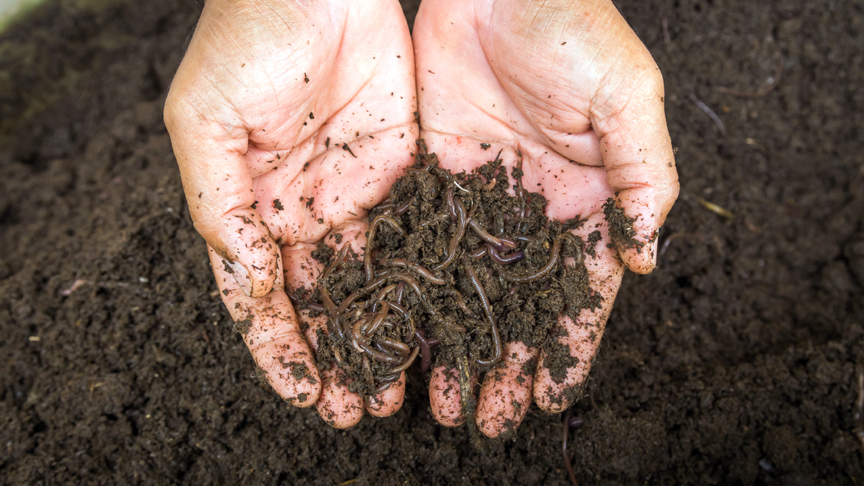An optimal humus content and appropriate nutrient ratio are essential for the stable soil structure, good water management and balanced nutrient availability. In doing so, both fertiliser and crop rotation play a crucial role on arable land. Thus, for example, in arable crop rotations the humus content of the soil is reduced by high shares of root crops. Cereals without the removal of thatch, on the other hand, are among the humus-protective crops, trefoil in turn is among the humus-increasing crops.
Obtain humus content and support it
The humus is more than just the died-off, organic soil matter of plant and animal origin in the soil. The humus is the result of soil-biological processes subject to cultivation, type of fertiliser and climate. Therefore, to maintain the humus stock in the arable soil it is absolutely essential to supply the nutrients and organic substances that have been removed. Crop residues and root remains, catch crops and even business-own fertilisers support the biological activity of soils, loosen the topsoil and establish the humus.
A high humus share also has a positive effect on the stability of the soil pore space and in doing so effects the water management and storage capacity. Humus consists of about 60 percent carbon, 6 percent nitrogen and proportionately of phosphorous and sulphur. The higher the humus, the higher the potential utilisation of N and P.
A higher share of humus in the soil therefore maintains soil fertility and supports good water and nutrient supply of crop plants. As a result, the humus content in arable soils is of great significance both ecologically and in terms of business during a time of climate change and increasing environmental requirements.
Tips for supporting and maintaining the humus content of arable soils:
• diverse crop rotations, cultivation of catch crop mixes, nurse crops
• supply of organic substance
• reduction in soil compaction
• site-specific soil cultivation and sowing
• good lime supply (Ca and Mg) for the adjustment to optimal pH values
• promotion of soil structure and soil biology
• securing sulphur supply
Fertilising increases yield potential of soil
Agriculturally used soils are depleted of plant nutrients every harvest. This applies in larger quantities particularly to essential plant nutrients such as nitrogen, phosphorous and potassium. In addition to this are indispensable plant nutrients such as magnesium, calcium and sulphur. Regular liming (Ca, Mg carbonate) promotes the humus fraction, which ensures a higher water and nutrient capacity, and has a positive effect on the stability of the soil structure as well as the nutrient availability. A soil pH value of 7.0 should not be exceeded in this context!
Fertilisation measures therefore serve the return of nutrients to arable soils. Plants need these nutrients for stable development and optimal growth. It is only possible to provide the plants with a continual availability of nutrients with a very good soil fertility and high yield potential. The combination of organic and mineral fertiliser promotes the nutrient efficacy for stable, high yields and provides a buffer in terms of yield waste in dry years.
C/N/P/S-ration of soils – important indicator of nutrient availability
The humus also acts as a storage unit for plant nutrients, such as nitrogen, phosphorous, sulphur and micronutrients. Humic substances positively influence the availability of anorganic elements, e.g. phosphate and potassium. The average C/N/P/S-ratio of soils can be specified as 140:10:1.3:1.3. This ratio is an indicator of the N/P/S availability for plants and micro-organisms, as well as the parameters for the degradability of organic substances and their development.
Sulphur is primarily saved in the organic substance (60 – 98 %), with phosphorous it is 15 – 80 %, therefore much more variable. Less humus therefore means too little, too late or interrupted plant availability to the named elements. Both require soil temperatures above 10 °C and sufficient moisture in order to effectively support the plant’s growth. Here a prompt, mineral fertiliser helps to make the corresponding nutrients available.
Sulphur extracted from the organic substance must be sufficiently re-fertilised in order to ensure the benefits of humus and, as a minimum, to maintain the humus content. The sulphur content in organic fertilisers is not sufficient for this. Sulphur loss occurs in situations such as too much rain or ground that has not been covered with plants. A sufficient liming also helps in this instance to keep sulphate in the root zone and available to the plants.



